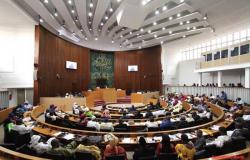Content reserved for subscribers
The construction of the new building, planned on the site of the Henri Tower, would constitute an attack on the industrial heritage of Fribourg, believe the Federal Commission for the Protection of Nature and Landscape and the Federal Commission for Historic Monuments.
According to federal experts, the Tivoli district, which would be razed to make way for the new building of the Faculty of Law, would constitute a valuable testimony to the industrialization of Freiburg. © Charles Ellena
Published on 05/31/2024
Estimated reading time: 5 minutes
Described as a “monolithic volume” in an expert report from the Federal Commission for Nature and Landscape Protection (CFNP) and the Federal Commission for Historic Monuments (CFMH), the project for a new building for the Faculty of law of the University of Fribourg, planned on the site of the Henri Tower, is not unanimous in heritage defense circles. As revealed on Friday by Freiburger Nachrichten, the CFNP and the CFMH do not only criticize the massive appearance of this building in the shape of a prism with a triangular base, a project by the Zurich office Ruprecht Architekten, winner in 2014 of the architectural competition launched by the State of Fribourg. They also regret that its construction, currently estimated at around 150 million francs, involves razing the last remaining buildings in the old Tivoli district, witness to the industrialization of Friborg between the end of the 19th century.e and the beginning of the 20th centurye century.
While a solution has finally been found concerning the relocation of the Tremplin reception center for drug addicts, a prerequisite for the start of construction on the new Faculty of Law, planned for 2027, a new obstacle stands in the way of the already long and bumpy road to this project awaited for three decades by Friborg jurists. On the side of the State of Fribourg, we take note of the report of the two federal commissions. It was the canton which had requested their expertise as part of the usual prior examination procedure, the Friborg Directorate of Territorial Development, Infrastructure, Mobility and Environment (DIME) was told.
Weighing of interests
However, this document only constitutes one of the elements of the file. “We will analyze this expertise with all the services involved and we will draw the necessary conclusions for the future,” assures the boss of DIME, Jean-François Steiert. On the basis of this analysis and feedback from other stages of the procedure (preliminary examination, public inquiry), the Council of State will carry out a “weighing of all the interests present”.
As the CFNP and the CFMH themselves point out, the federal law on the protection of nature and the landscape provides for a balancing of the interests of heritage protection with other national interests, such as university training. and more dense and efficient use of space. The two federal commissions add that if this weighing of interests were to lean in favor of the project, it would nevertheless have to “satisfy the requirement of the greatest possible care”. According to them, the State should in particular demonstrate that it cannot be carried out elsewhere and that all the optimizations proportionate in favor of the heritage to be safeguarded have been exhausted.
“Significant harm”
According to the expert opinion, the Henri Tower project, in its current form, represents a “significant attack” on a “built site of national importance”. The old Tivoli district, part of which has already been demolished to make way for the current temporary car park adjoining the 15th century towere century, was built around the former Henri Claraz paper factory (Avenue de l’Europe 2) and the former Laiterie Centrale (Avenue de Tivoli 5), built after the laying of the railway line. The complex now comprising seven buildings also includes Maison Hertling (Avenue de l’Europe 4), which could well be the first rental villa in the new Fribourg. All these buildings constitute a “precious and rare testimony” of the first industrial and artisanal district built in connection with the arrival of the railway.
“The Cantonal Commission for Cultural Property did not question the project in substance”
Stanislas Rück
The DIME recalls, however, that the Cantonal Cultural Property Service (SBC) had not proposed any specific protection measures. The census took place in 2016, therefore after the urban planning competition (2011) and after the project competition (2014) relating to the new Faculty of Law, recalls Stanislas Rück, head of the SBC. “Three of the seven buildings have been identified, but the service did not request protection measures during the general revision of the local development plan of Fribourg, considering that the weighing of interests had already been done upstream in particular by the competition procedures cited.”
Unsuitable for topography
Concerning the new building project itself, he specifies that it was submitted to the Cantonal Cultural Property Commission as part of the prior application procedure. “The commission did not question the project in substance but made several comments on the general volume, the heights, the treatment of the base and the facades.”
The CFNP and the CFMH were less lenient. “With its monolithic volume, the future building dominates the historic university building. Although located below, the planned building is in a dominant position in relation to the Miséricorde complex,” they write in particular. The project would not adapt to the topography and will involve the total disappearance of the neighborhood structure.
Experts also deplore the fact that the removal of the underground parking ramp located at the foot of the Henri Tower and the relocation of the Mensa, which were part of the winning project, were abandoned in its current version. “This decision is regrettable because it will not make it possible to improve the seriously degraded quality of the outdoor spaces around the fortification works and along the Miséricorde University,” they believe.







